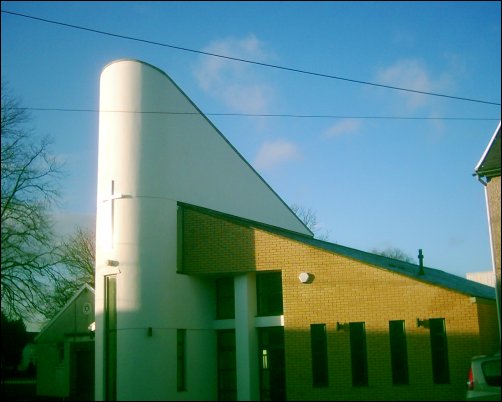OUR LADY OF THE ROSARY
CATHOLIC CHURCH
MARGARET STREET
(Built 1926, rebuilt 2004)The late nineteenth century saw a huge influx of people into the Amman valley seeking employment in the rapidly expanding coal and tinplate industries. Naturally, housing and other services had to be built for them, but they also demanded places to worship. There was initially no church in Ammanford where Anglicans could pray, forcing them to travel either to Betws or Llandybie, whose ancient churches soon proved too small for the thousands who poured into the valley. Places for nonconformist to worship had been in existence since the 18th century, and the growth of chapels in the nineteenth century kept pace with the population, but it wasn't until 1885 that the Church of St. Michael's and all Angels was built on Wind Street for followers of the established church. Even this soon proved inadequate and the Church of All Saints was built on Brynmawr hill in 1915 to cater for English-speaking worshippers (St. Michael's was where churchgoers could offer praise to their God in Welsh).
A small but significant number of people who had taken up residence in the Amman Valley followed the Catholic faith however, and they too had nowhere to celebrate the Mass. In the early 1920s they worshipped in the shabby Ivorites Hall on Hall Street as a temporary expedient. This was never going to be a long-term solution, however, and the dedicated members later acquired a former chapel property in Margaret Street which they converted for their own use, the church to become known as Our Lady of the Rosary. (A history of the Ivorites Hall can be found in the 'History' section of this website or click HERE.
At the inaugural service in October 1926, a Mission conducted by Father Joseph Smith of St. Mary's, Carmarthen, was arranged, comprising of a service and Mass every day for a week. From newspaper reports of the event, it appears that these services were well attended by both Catholics and Non-Catholics. One unusual feature was the placing of a 'question box' at the entrance of the Church, whereby matters concerning the belief and practices of the Catholic Church could be submitted by enquirers, with these questions then answered by the priest prior to his sermon at the evening services.
The first priest to take up ordination at the Church was Father Fenial Connell. A strong, united membership gave unsurpassed support to the new Church, who were soon able to raise the substantial cost of an extension to the church premises, a large hall to be known as the Catholic Hall. The accommodation was designed to hold fund raising events, such as dances, a skating rink, concerts and other social events.
The Hall, the brainchild of Father O'Rourke, was opened by Lady Stepney Howard of Llanelly on Thursday, the 7th of January 1932, and the occasion was celebrated by a Ball (the social event of the year, by all accounts). Music was provided by Roy Desmond and his Arcadians, with Messrs. Dr. J.P. Dunne, Glanamman; Mr. D. H. Thomas JP of Glanamman; Mr. D. P Rees of Cwmgorse and Mr. George Davies of Ammanford, as Masters of Ceremonies.
The new Church of Our Lady of the Rosary, rebuilt in 2004 on the site of the original 1926 church. At that time it was the practice of newspapers to record such events in detail, including listing the names of the ladies present, along with a full description of dresses worn. Thus Mrs. Pugh of Llandybie, for instance, wore 'a green satin dress, with black coatee'; Miss D. Griffiths of Ammanford sported 'a black floral taffeta dress'; Miss Ada Bowen of Gorseinon chose 'a lemon satin dress'; Miss Winnie Hughes of Ammanford was more resplendent in a 'peach satin dress with coatee to match, trimmed with ermine'; the choice of Miss Megan Lake of Ammanford for the evening was 'a black net over white satin dress'; and Miss Elsie Burton strode out onto the dance floor in 'a powder blue silk merle dress' – to name but a few. Newspaper reports like this must have caused consternation amongst the ladies, forcing them to keep a larger wardrobe of dresses than was otherwise necessary in order to impress their fellow townswomen.
In 2003, the original 1926 building was demolished and a striking new church appeared in its place in June 2004, paid for by money raised by the church faithful. With money raised from the same source, the church hopes to build a completely new Hall in the future to replace the ancient 1932 building.
(Source: W.T.H. Locksmith, 'Ammanford: Origins of Street Names', 2000, page 151).
Date this page last updated: August 31, 2010

